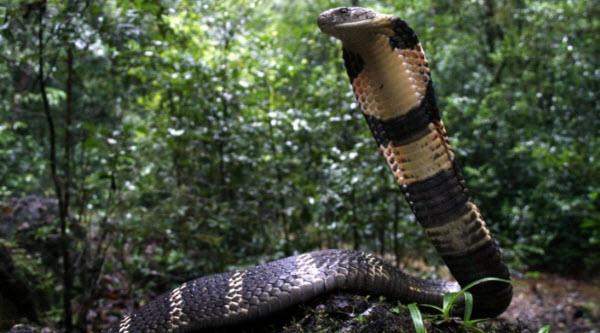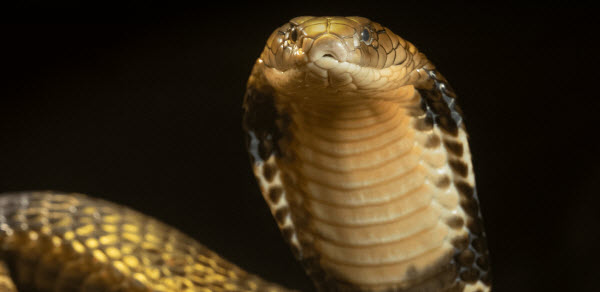The cobra is a venomous reptile belonging to the Elapidae family, which includes taipans, coral snakes, and mambas. Unlike other snakes, cobras cannot retract their fangs, which are short but highly effective. They use these fangs to inject a neurotoxic venom that enters the bloodstream, causing respiratory and cardiac arrest in their prey. There are over 20 species of cobras distributed across Asia and Africa. Naturally defensive, cobras typically do not attack humans unless threatened. They first warn by raising their bodies and spreading their hoods using muscles and ribs in their neck, accompanied by a deep hissing sound. If the threat persists, they will bite and inject venom, which can be fatal if not treated promptly. One of their fiercest enemies is the mongoose, which is fast enough to bite the cobra’s neck before it can defend itself.
In addition to biting species, there are “spitting cobras,” which can eject venom from their fangs as a defensive mechanism. Notable examples include the red spitting cobra, Mozambique spitting cobra, and black-necked spitting cobra. Although their venom is generally not lethal on contact with the skin, it can cause permanent blindness if it reaches the eyes, and untreated skin contact may lead to scarring. Specialists handling these cobras wear protective gear to shield their heads and eyes. Despite their name, spitting cobras do not actually spit; instead, they expel venom by contracting muscles around their venom glands, forcing it through the front openings in their fangs. When threatened, they can spit venom up to 2 meters away. There are four species of spitting cobras in Africa and seven out of nine in Asia. While spitting is their usual defense, they can also deliver venom through bites.

The Indian cobra, named after its native India, is known for its striking appearance with unique patterns on the back of its head resembling two connected circles, which look like a pair of eyes. This mimicry is believed to intimidate potential predators. Indian cobras are well-known in snake charming, though this practice has been banned in India since 1991 under the Wildlife Protection Act. They are voracious feeders, consuming large numbers of rats, and their venom is used in medical research for developing pharmaceuticals beneficial to humans. In Hindu mythology, the Indian cobra is highly revered and even considered a powerful deity. There are also monocled cobras with a single eye-like mark on the back of their head instead of two.

The Egyptian cobra, indigenous to the deserts of North Africa and the Middle East, is one of the largest and most infamous cobras in Africa, responsible for many fatalities. It can reach up to 3 meters in length, and its venom is among the most potent, capable of causing rapid death if untreated. Many believe it was the snake used by Queen Cleopatra for suicide.
The king cobra, occasionally reaching up to 5.7 meters, is the longest venomous snake in the world. It is found throughout India, southern China, and Southeast Asia. The king cobra primarily preys on other snakes, including venomous ones. When threatened, it spreads its head like a hood and hisses loudly, raising up to one-third of its body length. In some cases, it can be taller than an average person.

Cobras inhabit both Africa and Asia, favoring savannahs, open lands, plains, and rocky hills. They hunt primarily at dawn and dusk and can survive for days or even months without food, thanks to a slow metabolism. Their diet includes rodents, ground squirrels, rabbits, amphibians, birds, lizards, other snakes, and eggs. Cobras use their forked tongues to track prey by picking up scent particles from the ground and transferring them to the Jacobson’s organ in the roof of their mouth. Like other venomous snakes, they strike swiftly and may bite multiple times to ensure effective venom delivery.

For reproduction, female cobras lay a clutch of eggs annually and guard them until they hatch. The hatchlings are self-sufficient from birth and can expand their heads in the characteristic manner. A large yolk sac in their stomach provides nourishment for up to two weeks before they need to find food independently. Most cobras protect their eggs post-laying, except for the king cobra mother, which builds a nest of leaves using her body and head to arrange the materials, covering the eggs and coiling around them until they hatch.
The International Union for Conservation of Nature (IUCN) assesses plant and animal species’ conservation statuses to identify those at risk of extinction, publishing their findings in the Red List of Threatened Species. Several cobra species are threatened or near-threatened, with the Sao Tome cobra being critically endangered due to habitat destruction, agricultural conversion, and poaching for illegal wildlife trade.
Identification Card

- Class: Reptiles
- Order: Squamata
- Family: Elapidae
- Species: Over 20
- Lifespan: 20 to 30 years
- Incubation Period: 45 to 80 days, with 12 to 60 eggs depending on the species
- Hatchling Size: 40 to 45 cm
- Maturity: 4 to 6 years
- Length: King cobras up to 5.7 meters; other species range from 0.9 to 2.1 meters
- Weight: Average 9 kg, depending on the species
Quick Facts About Cobras
- Some cobras may feign death by convulsing and lying still until the threat is gone.
- Like all snakes, cobras have two independent jawbones loosely connected to their skull, allowing them to swallow prey larger than their head.
- Large cobras have been known to challenge a herd of elephants to halt their advance with a warning display.
